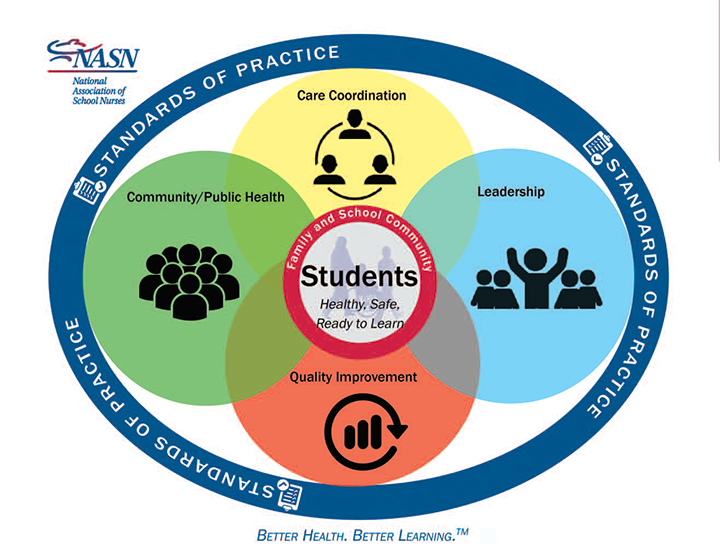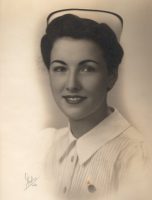This specialty provides many challenges—and rewards.
Takeaways:
- School nurses play an integral role in the health of children and youth, by increasing access to healthcare, addressing social determinants of health, and providing essential care coordination.
- School nursing specialty practice is frequently overlooked, but it’s been shown to be cost-effective and to improve health outcomes.
- Challenges of funding, variation in how school nursing is practiced across the country, and a decreasing pipeline threaten this rewarding profession.
The COVID-19 pandemic has highlighted the work of school nurses, who play a critical role in maintaining the health and well-being of children, families, and communities. They’re particularly integral to healthcare access for children whose health is impacted by social determinants. In fact, many consider school nurses the hidden healthcare system for vulnerable youth. Widespread understanding of the breadth and depth of professional school nursing is needed to ensure the growth of this critically important nursing specialty and to protect children’s health.
School nursing defined
The National Association of School Nurses (NASN) defines school nursing as a specialized practice that “protects and promotes student health, facilitates optimal development, and advances academic success.” The NASN goes on to explain that school nurses are grounded in ethical and evidence-based practice and work as leaders to bridge healthcare and education. They coordinate care, advocate for quality student-centered care, and work with others to design systems that allow individuals and communities to develop to their fullest potential. Functioning within local educational systems, school nurses help to ensure children have access to education by providing and managing complex care across multiple healthcare sectors, including public health, community agencies, hospitals, and insurance systems.
School nursing practice is guided by the NASN’s Framework for 21st Century School Nursing Practice, which articulates the key principles of evidence-based school nursing practice: care coordination, leadership, quality improvement, and community/public health. (See Practice framework.) Upholding these principles requires collaboration across disciplines and settings that includes teachers, school staff and administrators, community providers, insurance providers, and parents and guardians. For example, a student may visit the school nurse on a Monday describing a weekend visit to the emergency department for asthma exacerbation. Immediately, the nurse begins coordinating the care this student might need—health teaching for the student and family, communicating with the student’s classroom and physical education teachers to determine any necessary accommodations, reviewing the student’s health record to ensure flu shots are up-to-date, and, as needed, helping with health insurance applications and follow-up appointments with a healthcare provider. The nurse also may work with the building and grounds keepers to help eliminate triggers. These collaborations are critical in school nurses’ work.
Practice framework
The National Association of School Nurses Framework for 21st Century School Nursing Practice is built on four evidence-based principles—care coordination, leadership, quality improvement, and community and public health.


School nursing practice is regulated by state nurse practice acts and standards of practice and ethics. What makes school nursing unique from other specialties, however, is that school nurses work within local or state educational systems. Therefore, school nursing practice must adhere to the legal mandates of the nursing profession and conform with education-specific state statutes (for example, those related to sexual health education and automated external defibrillator training) and federal law (for example, Title IX). In this way, school nurses have specialized knowledge that straddles both the health and education systems.
An NASN Workforce Study reports that approximately 132,000 practicing school nurses (95,000 full-time equivalents) care for the nation’s 56 million children. About half (53%) of public school nurses are baccalaureate-prepared RNs.
On the job
Once stereotyped as a slow-paced, low-skill position, school nurses today care for students with complex conditions that require higher-level acute care nursing proficiency. In addition to direct care, school nurses must have exceptional advocacy, public health, and leadership skills. These efforts to positively impact health and improve student attendance rates are critical to extending children’s educational opportunities.
Direct care
School nurses make treatment decisions that may be as simple as applying an ice pack but as complex as an emergency intervention with epinephrine, albuterol, or glucagon. Similarly, the care they provide can range from taking a temperature to tracheostomy care, catheterization, and gastrostomy tube feedings. School nurses also work with families and interprofessional teams to coordinate care for children with chronic conditions such as asthma and diabetes. As primary health educators, school nurses teach students about disease management and help them provide their own developmentally appropriate self-care.
Kessler notes that about half of mental health conditions develop before age 14, which means that school nurses frequently are the first to notice early warning signs and can provide initial assessment and support. School nurses foster an inclusive environment by creating a safe space in the health room for those struggling with bullying or other issues such as anxiety, depression or gender identity development.
If a student has been hospitalized for a physical or mental health condition, the school nurse works with hospital teams, in collaboration with the student and family, to develop successful school re-entry plans.
The school nurses’ work isn’t limited to students. Teacher and staff health and wellness and disaster preparedness also fit within the scope of school nursing practice.
Advocacy
School nurses advocate for healthier environments by identifying and developing health and wellness policies. Examples include self-carry rules for rescue inhalers, breast-feeding guidelines for students and staff, bus idling policies to mitigate air pollution, and standards on food in the classroom.
School nurses are trained to identify risk factors and detect illness at the population level, making them crucial to public health and surveillance efforts. Surveillance activities include reporting disease outbreaks (for example, measles or mumps) to public health departments. School nurses are playing an important role in the current COVID-19 crisis by coordinating health and nutrition needs while students are out of school and ensuring that schools are ready when students return. The role of the school nurse is vast, highly specialized, and immensely rewarding. (See Student and school benefits.)
Student and school benefits
Research demonstrates that students are healthier when professional registered school nurses are present. Pennington and Delany found that compared to nonlicensed personnel, school nurse presence was linked to decreased absenteeism and fewer early school dismissals. School nurses also have been associated with improved asthma and mental health outcomes, greater immunization adherence, and lower A1c levels in students with diabetes, according to studies by Rodriguez and colleagues and Telljohann and colleagues.
In addition, Wang and colleagues reported—in one of the few cost-benefit analysis studies of school nurses conducted—that $2.20 was saved for every dollar spent on school nursing services in 2014.
Looking forward: Challenges and opportunities
School nursing faces many challenges, but these challenges also present opportunities to effect positive change.
Funding challenge
Limited and varied funding remains one of the primary challenges to delivering comprehensive, evidence-based school nursing services. Although schools can bill for specific services through Medicaid and partially fund a small portion of nursing services, according to an NASN Workforce Study, most school nursing services (74.1%) are funded through local education dollars, with additional funding coming from states, health departments, and hospitals. Local education funding means that school nursing services must compete with teachers, support staff, and education-related expenses, such as textbooks and tablets. And because school nurses function within the education sector, health services frequently are managed by administrators who may not understand what’s needed to effectively care for a diverse student population. With limited funds allocated to education, administrators look to make cuts “outside” of the classroom, which frequently results in reducing or eliminating school nurses and other professional support staff.
Opportunity. The need to ensure educational access by keeping children healthy and ready to learn presents policy makers and school districts with an opportunity to strategize on stable funding streams that support school nursing. For example, to provide a more reliable funding source for school nurses, some school districts have developed partnerships with health systems, including hospitals. In these partnerships, school districts contract out for school nursing services, which allows nurses to operate within a health infrastructure and ensures they have access to various resources (such as continuing education and mentorship) that otherwise might not be available to them. In addition, school and health system partnerships make health records more interoperable, which facilitates efficient care coordination.
Preparation and allocation challenges
The preparation and allocation of school nurses vary across the 50 states because of several factors, including state nurse practice acts, licensure and certification requirements, and local school district regulations. Although professional organizations recommend that school nurses be, at a minimum, baccalaureate-prepared, some states employ associate-prepared nurses or licensed practical nurses (LPNs). In addition, school nurse educational and certification requirements differ across states, which influences the type and level of care that can be provided. How school nurses are deployed and used frequently are pragmatic decisions—the limited number of school nurses relative to need impacts school district staffing decisions. As a result of these factors, schools may have RNs, LPNs, and/or health room aides who cover one to three schools of varying sizes.
Opportunity. Maughan states that caseloads among school nurses can range from 300 to 6,000 students per nurse. Research by Jameson and colleagues indicates that a multi-faceted formula is needed to guide workload and staffing considerations, and a 2015 NASN position statement notes that: “school nursing services must be determined at levels sufficient to provide the range of health care necessary to meet the needs of school populations.” Comprehensive metrics to guide staffing could include the number of students on free or reduced lunch, number of children with medically complex needs, types of interventions needed, experience level of the school nurse, school academic performance, and number of and distance between school buildings. (See Every student counts.)
Every student counts
Quantifying the unique contributions of school nurses to the health of schools and communities requires studies that compare the association between different nursing skill mixes (for example, RN in every school) and consistent quality measures specific to school nursing. School nurse–sensitive outcome measures form the basis of “Every Student Counts!” (nasn.org/nasn/research/everystudentcounts) a National Association of School Nurses initiative to develop a robust school health data set to support school nursing policy decisions.
The initiative facilitates the use of standardized data to ensure information across settings and states are comparable. Currently, the dataset has 30 variables, with data collection occurring in every state. School nurses, through data collection, play a critical role in articulating optimal school nursing models.
Workforce challenge
An NASN Workforce Study reported that almost half of the school nurse workforce is over age 50 and only 5.4% are under age 30, indicating that the school nursing workforce is aging. Unfortunately, little attention is being paid to increasing the pipeline. Compounding this challenge is the fact that school nurse salaries aren’t uniformly commensurate with nurses in other specialties.
Opportunity. These data point to the critical need to intensify efforts to recruit, retain, compensate, and diversify the school nursing workforce. Nurses who transition to the school nursing specialty have a range of work experiences, such as in emergency care, pediatrics, and mental health. The specialty provides an opportunity to make a difference not only through practice, but also in the areas of education, policy, and practice. (See Recruitment.)
Recruitment
Recruitment efforts to increase the school nursing workforce involve intentional and strategic partnerships with academia, schools, professional nursing organizations, and school nurses.
Academia
Academic institutions can be powerful partners in developing the school nurse workforce by
- integrating the school nursing specialty more visibly into nursing school curricula
- providing training opportunities in other health professions’ curricula to help students learn about school nurses and their role
- integrating school nurse clinical experiences in nursing schools
- partnering with local school districts to support the professional development of school nurses.
Schools
School districts can support the workforce by
- developing and implementing robust orientation programs
- providing on-going professional development
- creating work environments that meaningfully support the work of school nurses.
Professional organizations
Professional nursing organizations can bring attention to school nursing by
- including information about the specialty in their recruiting efforts.
School nurses
School nurses can serve as valuable role models for aspiring nurses to ensure a workforce that
- mirrors the populations they serve
- is diverse in knowledge, skills, and experience.
Reliable leadership
School nurses are on the frontline addressing children’s healthcare needs and keeping them healthy for academic success. School nursing builds on the breadth and depth of professional nursing practice with new challenges each day, which require knowledge of emergency care, public health, occupational health, disaster management, surveillance, tracking, direct care, population health, case management, and behavioral health. As the only health experts in schools, school nurses are relied on for their leadership, critical thinking, and communication skills. School nursing represents an important opportunity not only to practice at the full scope of professional nursing, but also to demonstrate a profound impact on nursing-sensitive outcomes and community health.
Mayumi A. Willgerodt is an associate professor and vice chair for education in child, family, and population health nursing at the University of Washington in Seattle. Catherine Yonkaitis is a clinical assistant professor and director of the advanced population health DNP program in population health nursing science at the University of Illinois at Chicago.
References
American Nurses Association, National Association of School Nurses. School Nursing: Scope and Standards of Practice. 3rd ed. Silver Spring, MD: American Nurses Association; 2017.
Council on School Health. Role of the school nurse in providing school health services. Pediatrics. 2016;137(6):e20160852.
de Girolamo G, Dagani J, Purcell R, Cocchi A, McGorry PD. Age of onset of mental disorders and use of mental health services: Needs, opportunities and obstacles. Epidemiol Psychiatr Sci. 2012;21(1):47-57.
Jacobson J, Kennedy MS. School nurses nationwide respond to influenza A (H1N1) outbreaks. Am J Nurs. 2009;109(6):19.
Jameson BE, Engelke MK, Anderson LS, Endsley P, Maughan ED. Factors related to school nurse workload. J Sch Nurs. 2018;34(3):211-21.
Kessler RC, Amminger GP, Aguilar-Gaxiola S, Alonso J, Lee S, Ustün TB. Age of onset of mental disorders: A review of recent literature. Curr Opin Psychiatry. 2007;20(4):359-64.
Leroy ZC, Wallin R, Lee S. The role of school health services in addressing the needs of students with chronic health conditions. J Sch Nurs. 2017;33(1):64-72.
Maughan E. Part 1—Factors Associated with School Nurse Ratios: An analysis of state data. J Sch Nurs. 2009;25(3):214-21.
National Association of School Nurses. School nurse workload: Staffing for safe care. 2020. nasn.org/nasn/advocacy/professional-practice-documents/position-statements/ps-workload
National Association of School Nurses. Framework for 21st century school nursing practice: National Association of School Nurses. NASN Sch Nurse. 2016;31(1):45-53.
National Association of School Nurses. The role of the 21st-century school nurse. NASN Sch Nurse. 2017;32(1):56-8.
National Center for Education Statistics. Back to school statistics. Fast Facts. nces.ed.gov/fastfacts/display.asp?id=372
Pansier B, Schulz PJ. School-based diabetes interventions and their outcomes: A systematic literature review. J Public Health Res. 2015;4(1):467.
Pennington N, Delaney E. The number of students sent home by school nurses compared to unlicensed personnel. J Sch Nurs. 2008;24(5):290-7
Rodriguez E, Rivera DA, Perlroth D, Becker E, Wang NE, Landau M. School nurses’ role in asthma management, school absenteeism, and cost savings: A demonstration project. J Sch Health. 2013;83(12):842-50.
Telljohann SK, Dake JA, Price JH. Effect of full-time versus part-time school nurses on attendance of elementary students with asthma. J Sch Nurs. 2004;20(6):331-4.
Wang LY, Vernon-Smiley M, Gapinski MA, Desisto M, Maughan E, Sheetz A. Cost-benefit study of school nursing services. JAMA Pediatr. 2014;168(7):642-8.
Willgerodt MA, Brock DM, Maughan ED. Public school nursing practice in the United States. J Sch Nurs. 2018;34(3):232-44.
Article updated March 4, 2021 to clarify NASN position on school nurse staffing.



















2 Comments.
This is a really great article! I am a school nurse, finishing up my 9th year at a large high school. I am also finishing up my MSN, and have been a registered nurse for 17 years. I have a passion for school nursing, and this article is spot on! Serving the students and staff with nursing is a joy, and a challenge. I love doing it!
I really enjoyed reading this article. As a student nurse myself I feel like it expands the option of the type of Nurse my classmate or myself would want to be. Just a couple of days ago a classmate and I were talking about other nursing option then being a bedside nursing. I mentioned to her to look into school nursing in the community sector. I remember my friend who told me about the ANA for students, sharing a list that was posted with in the last year about other nursing opportunities outside of the hospital. I love that I have access to these resources.